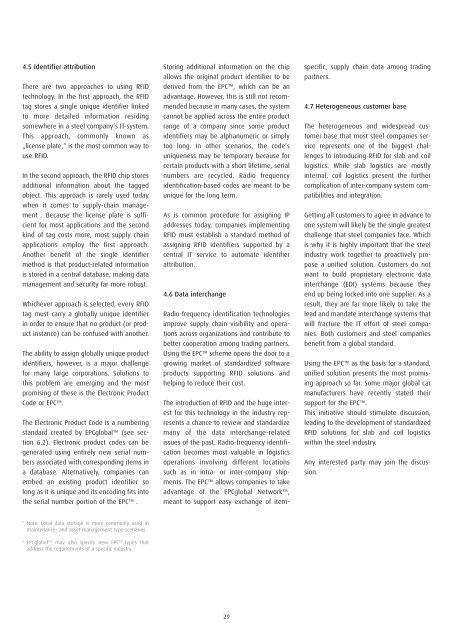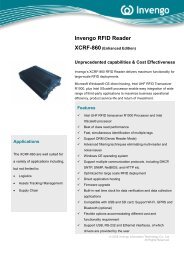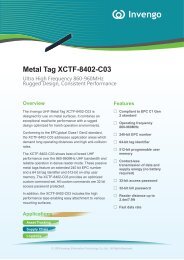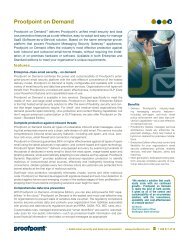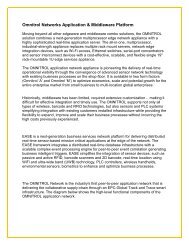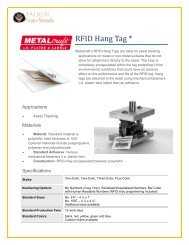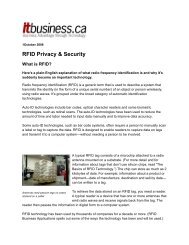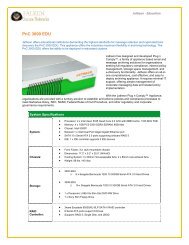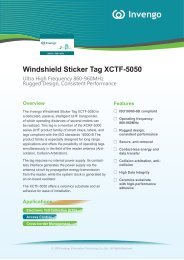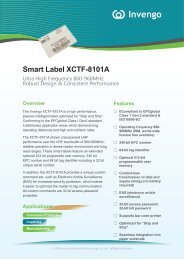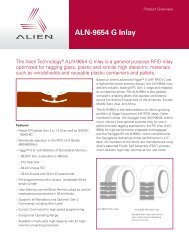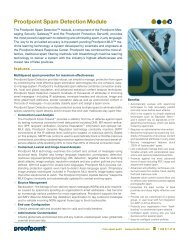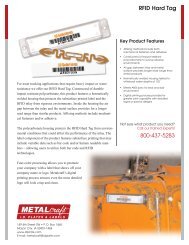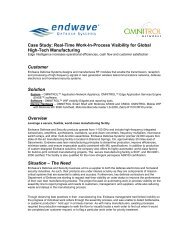The Benefits of RFID for Slab- and Coil-Logistics - Falken Secure ...
The Benefits of RFID for Slab- and Coil-Logistics - Falken Secure ...
The Benefits of RFID for Slab- and Coil-Logistics - Falken Secure ...
You also want an ePaper? Increase the reach of your titles
YUMPU automatically turns print PDFs into web optimized ePapers that Google loves.
4.5 Identifier attribution<br />
<strong>The</strong>re are two approaches to using <strong>RFID</strong><br />
technology. In the first approach, the <strong>RFID</strong><br />
tag stores a single unique identifier linked<br />
to more detailed in<strong>for</strong>mation residing<br />
somewhere in a steel company’s IT-system.<br />
This approach, commonly known as<br />
„license plate,“ is the most common way to<br />
use <strong>RFID</strong>.<br />
In the second approach, the <strong>RFID</strong> chip stores<br />
additional in<strong>for</strong>mation about the tagged<br />
object. This approach is rarely used today<br />
when it comes to supply-chain management<br />
. Because the license plate is sufficient<br />
<strong>for</strong> most applications <strong>and</strong> the second<br />
kind <strong>of</strong> tag costs more, most supply chain<br />
applications employ the first approach.<br />
Another benefit <strong>of</strong> the single identifier<br />
method is that product-related in<strong>for</strong>mation<br />
is stored in a central database, making data<br />
management <strong>and</strong> security far more robust.<br />
Whichever approach is selected, every <strong>RFID</strong><br />
tag must carry a globally unique identifier<br />
in order to ensure that no product (or product<br />
instance) can be confused with another.<br />
<strong>The</strong> ability to assign globally unique product<br />
identifiers, however, is a major challenge<br />
<strong>for</strong> many large corporations. Solutions to<br />
this problem are emerging <strong>and</strong> the most<br />
promising <strong>of</strong> these is the Electronic Product<br />
Code or EPC.<br />
<strong>The</strong> Electronic Product Code is a numbering<br />
st<strong>and</strong>ard created by EPCglobal (see section<br />
6.2). Electronic product codes can be<br />
generated using entirely new serial numbers<br />
associated with corresponding items in<br />
a database. Alternatively, companies can<br />
embed an existing product identifier so<br />
long as it is unique <strong>and</strong> its encoding fits into<br />
the serial number portion <strong>of</strong> the EPC .<br />
5 Note: Local data storage is more commonly used in<br />
maintenance- <strong>and</strong> asset-management type scenarios.<br />
6 EPCglobal may also specify new EPC-types that<br />
address the requirements <strong>of</strong> a specific industry.<br />
Storing additional in<strong>for</strong>mation on the chip<br />
allows the original product identifier to be<br />
derived from the EPC, which can be an<br />
advantage. However, this is still not recommended<br />
because in many cases, the system<br />
cannot be applied across the entire product<br />
range <strong>of</strong> a company since some product<br />
identifiers may be alphanumeric or simply<br />
too long. In other scenarios, the code’s<br />
uniqueness may be temporary because <strong>for</strong><br />
certain products with a short lifetime, serial<br />
numbers are recycled. Radio frequency<br />
identification-based codes are meant to be<br />
unique <strong>for</strong> the long term.<br />
As is common procedure <strong>for</strong> assigning IP<br />
addresses today, companies implementing<br />
<strong>RFID</strong> must establish a st<strong>and</strong>ard method <strong>of</strong><br />
assigning <strong>RFID</strong> identifiers supported by a<br />
central IT service to automate identifier<br />
attribution.<br />
4.6 Data interchange<br />
Radio-frequency identification technologies<br />
improve supply chain visibility <strong>and</strong> operations<br />
across organizations <strong>and</strong> contribute to<br />
better cooperation among trading partners.<br />
Using the EPC scheme opens the door to a<br />
growing market <strong>of</strong> st<strong>and</strong>ardized s<strong>of</strong>tware<br />
products supporting <strong>RFID</strong> solutions <strong>and</strong><br />
helping to reduce their cost.<br />
<strong>The</strong> introduction <strong>of</strong> <strong>RFID</strong> <strong>and</strong> the huge interest<br />
<strong>for</strong> this technology in the industry represents<br />
a chance to review <strong>and</strong> st<strong>and</strong>ardize<br />
many <strong>of</strong> the data interchange-related<br />
issues <strong>of</strong> the past. Radio-frequency identification<br />
becomes most valuable in logistics<br />
operations involving different locations<br />
such as in intra- or inter-company shipments.<br />
<strong>The</strong> EPC allows companies to take<br />
advantage <strong>of</strong> the EPCglobal Network,<br />
meant to support easy exchange <strong>of</strong> item-<br />
29<br />
specific, supply chain data among trading<br />
partners.<br />
4.7 Heterogeneous customer base<br />
<strong>The</strong> heterogeneous <strong>and</strong> widespread customer<br />
base that most steel companies service<br />
represents one <strong>of</strong> the biggest challenges<br />
to introducing <strong>RFID</strong> <strong>for</strong> slab <strong>and</strong> coil<br />
logistics. While slab logistics are mostly<br />
internal, coil logistics present the further<br />
complication <strong>of</strong> inter-company system compatibilities<br />
<strong>and</strong> integration.<br />
Getting all customers to agree in advance to<br />
one system will likely be the single greatest<br />
challenge that steel companies face. Which<br />
is why it is highly important that the steel<br />
industry work together to proactively propose<br />
a unified solution. Customers do not<br />
want to build proprietary electronic data<br />
interchange (EDI) systems because they<br />
end up being locked into one supplier. As a<br />
result, they are far more likely to take the<br />
lead <strong>and</strong> m<strong>and</strong>ate interchange systems that<br />
will fracture the IT ef<strong>for</strong>t <strong>of</strong> steel companies.<br />
Both customers <strong>and</strong> steel companies<br />
benefit from a global st<strong>and</strong>ard.<br />
Using the EPC as the basis <strong>for</strong> a st<strong>and</strong>ard,<br />
unified solution presents the most promising<br />
approach so far. Some major global car<br />
manufacturers have recently stated their<br />
support <strong>for</strong> the EPC.<br />
This initiative should stimulate discussion,<br />
leading to the development <strong>of</strong> st<strong>and</strong>ardized<br />
<strong>RFID</strong> solutions <strong>for</strong> slab <strong>and</strong> coil logistics<br />
within the steel industry.<br />
Any interested party may join the discussion.


